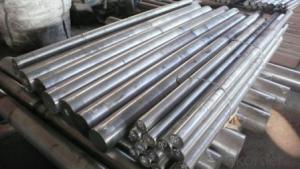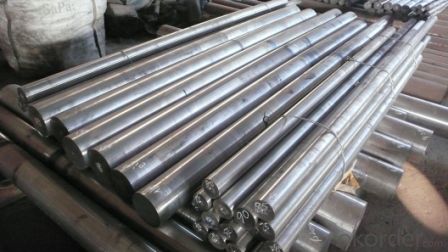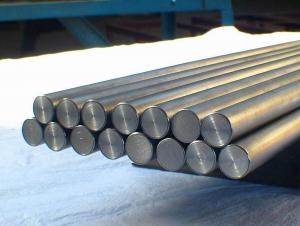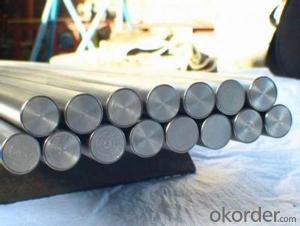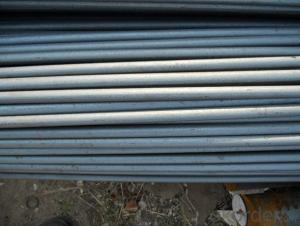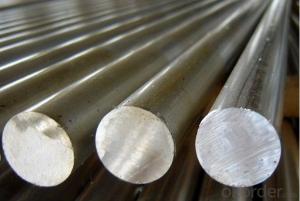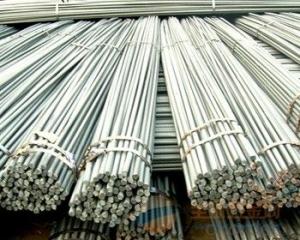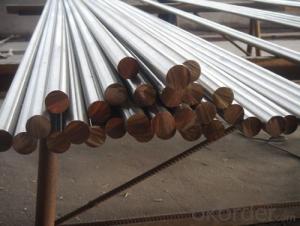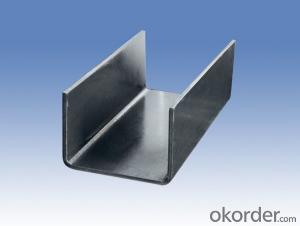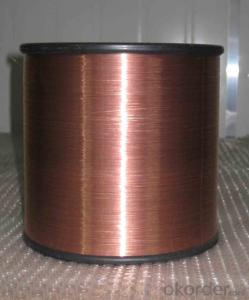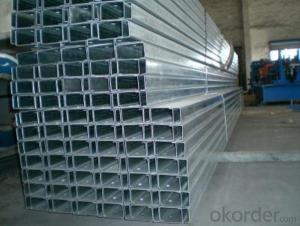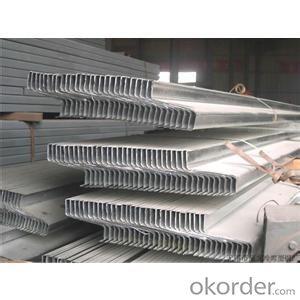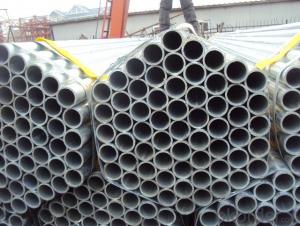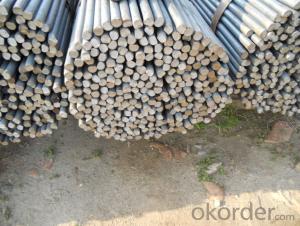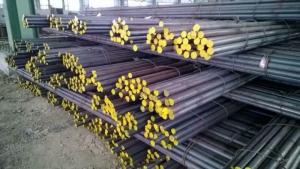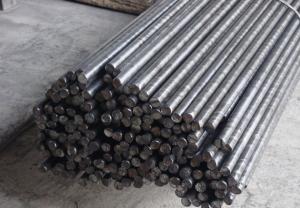Tool Steel with Many Kinds and Sizes
- Loading Port:
- China main port
- Payment Terms:
- TT or LC
- Min Order Qty:
- 25 m.t.
- Supply Capability:
- 10000 m.t./month
OKorder Service Pledge
OKorder Financial Service
You Might Also Like
Product Description:
OKorder is offering Tool Steel at great prices with worldwide shipping. Our supplier is a world-class manufacturer of steel, with our products utilized the world over. OKorder annually supplies products to European, North American and Asian markets. We provide quotations within 24 hours of receiving an inquiry and guarantee competitive prices.
Product Applications:
High Quality Bearing steel is used for manufacturing ball, roller bearing steel and rings. Bearing in work is under great pressure and friction, so have high demands bearing steel and hardness and resistance, and high elastic limit.
Bearing steels are used for ball and roller bearing applications and are comprised of low carbon steels and high carbon through harden able steel.
For example, bearing ring, steel rolling mill, machinery, 100Cr6 bearing steel ball is widely used in high-speed and low-noise bearing, bicycle, motorcycle, automobile, bags electronically.
Product Advantages:
OKorder's Tool Steel are durable, strong, and resist corrosion.
Main Product Features:
· Premium quality
· Prompt delivery & seaworthy packing (30 days after receiving deposit)
· Corrosion resistance
· Can be recycled and reused
· Mill test certification
· Professional Service
· Competitive pricing
Product Specifications:
Grade | bearing steel EN-31 |
Dimensions | Diameter: 20-280mm Length: 2000-5800mm |
Shape | Round Bar |
Type | High chromium bearing steel |
HBS | <220< span=""> |
Standard | AISI |
Technique | Hot Rolled |
Note of High Quality Bearing Steel
1. According to national standard (GB) for our products, if not, supply according to national standards (GB) or agreement.
2. We can not only provide electric furnace +LF+VD and electros lag re-melting (ESR) steel forging materials, but also forging products of piece, bar, etc.
3. Our company is equipped with roll equipment and can provide our customers with roll billets or finished.
4. The materials that we purchase are all accord with International General Standard; you could check it out on the Material Quality Sheet.
5. We are the creator of the “seven-step inspect method” in China.
FAQ:
Q1: Why buy Materials & Equipment from OKorder.com?
A1: All products offered byOKorder.com are carefully selected from China's most reliable manufacturing enterprises. Through its ISO certifications, OKorder.com adheres to the highest standards and a commitment to supply chain safety and customer satisfaction.
Q2: How do we guarantee the quality of our products?
A2: We have established an advanced quality management system which conducts strict quality tests at every step, from raw materials to the final product. At the same time, we provide extensive follow-up service assurances as required.
Q3: How soon can we receive the product after purchase?
A3: Within three days of placing an order, we will begin production. The specific shipping date is dependent upon international and government factors, but is typically 7 to 10 workdays.
Images:

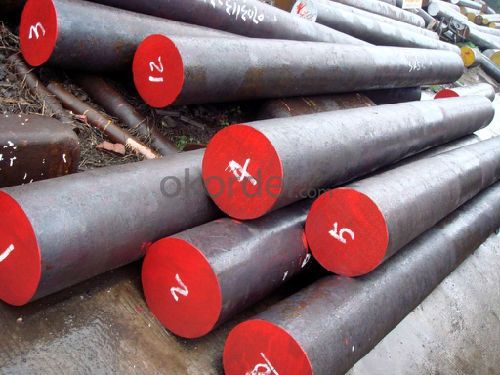
- Q: What is the difference between a hot-rolled and a ground steel round bar?
- A hot-rolled steel round bar is produced by heating the steel billet to a high temperature and then rolling it into its desired shape and size. This process gives the bar a rough surface finish. On the other hand, a ground steel round bar is produced by further processing the hot-rolled bar through grinding, which removes any surface imperfections and provides a smooth and polished finish. In summary, the main difference between the two is the surface finish, with hot-rolled having a rougher texture and ground having a smoother and more refined appearance.
- Q: What are the different types of steel round bars used in the automotive chassis components?
- There is a wide range of steel round bars commonly employed in automotive chassis components. These bars are selected based on their unique properties and performance criteria for different parts of the chassis. 1. Mild Steel Round Bars: Automotive chassis components often utilize mild steel round bars due to their well-balanced combination of strength, durability, and cost-effectiveness. These bars find application in various chassis parts such as brackets, supports, and reinforcements. 2. High-Strength Low-Alloy (HSLA) Steel Round Bars: HSLA steel round bars are crafted by combining low carbon content with small quantities of alloying elements like manganese, phosphorus, and chromium. This steel variant offers superior strength and enhanced formability compared to mild steel. Chassis components that demand critical performance, such as control arms, suspension components, and steering linkages, frequently incorporate HSLA steel round bars. 3. Boron Steel Round Bars: Boron steel round bars are renowned for their exceptional strength and resistance to deformation. These bars are alloyed with boron, which imparts high hardenability and toughness to the steel. Safety-critical chassis components like reinforced door beams and crash structures primarily employ boron steel round bars. 4. Stainless Steel Round Bars: Stainless steel round bars exhibit corrosion resistance alongside excellent strength and durability. While they are not as commonly employed in automotive chassis components, stainless steel round bars may be utilized in specialized parts that necessitate resistance to rust and corrosion, such as exhaust system components or parts exposed to harsh environmental conditions. 5. Alloy Steel Round Bars: Alloy steel round bars are produced by incorporating various alloying elements like nickel, chromium, and molybdenum to enhance specific properties such as strength, hardness, and wear resistance. These bars frequently find application in high-performance chassis components like drive shafts, axles, and gears. To summarize, the types of steel round bars utilized in automotive chassis components encompass mild steel, high-strength low-alloy steel, boron steel, stainless steel, and alloy steel. The selection of the appropriate type depends on the specific requirements of each component, including strength, durability, formability, and corrosion resistance.
- Q: How are steel round bars used in the manufacturing of heat exchangers?
- Steel round bars are commonly used in the manufacturing of heat exchangers as they provide structural support and durability to the equipment. These bars are often used as the framework or as internal support for the heat exchanger's core, ensuring stability and longevity. Additionally, steel round bars can be machined or formed into various shapes to accommodate specific design requirements, allowing for efficient heat transfer and optimal performance of the heat exchanger.
- Q: Can steel round bars be used in the production of sporting goods?
- Yes, steel round bars can be used in the production of sporting goods. Steel is a versatile material known for its strength and durability, making it suitable for various applications in the sporting goods industry. Steel round bars can be used to create components such as shafts, handles, frames, and supports in sporting equipment like golf clubs, hockey sticks, weightlifting bars, and exercise equipment. The high tensile strength of steel ensures that these components can withstand the forces and pressures exerted during sports activities, providing stability and longevity to the products. Moreover, steel round bars can be easily machined, welded, and molded into different shapes and sizes according to the specific requirements of each sporting good. Steel's corrosion resistance properties also make it ideal for outdoor sporting equipment that is exposed to various weather conditions. Overall, steel round bars are a popular choice in the production of sporting goods due to their strength, durability, versatility, and ability to withstand the demands of different sports.
- Q: What is the cost of a steel round bar?
- The cost of a steel round bar can vary depending on several factors such as the size, grade, and supplier. Generally, the larger the diameter and length of the round bar, the higher the cost. The grade of steel also plays a significant role in determining the price, as different grades have varying levels of strength and durability. Additionally, the supplier and location can impact the cost due to factors like transportation and market demand. To get an accurate cost estimate, it is best to contact a local supplier or check online metal marketplaces for current prices.
- Q: Can steel round bars be used for making valves or fittings?
- Yes, steel round bars can be used for making valves or fittings. Steel is a common material choice for valves and fittings due to its strength, durability, and resistance to corrosion. Steel round bars can be machined or forged into the desired shape for valves or fittings, ensuring that they meet the necessary specifications and requirements. Additionally, steel round bars can be heat-treated to enhance their mechanical properties and make them suitable for high-pressure or high-temperature applications. Overall, steel round bars are a versatile and reliable material option for manufacturing valves or fittings.
- Q: Can steel round bars be used in the construction equipment industry?
- Yes, steel round bars are commonly used in the construction equipment industry. Steel round bars are known for their strength, durability, and versatility, making them suitable for various applications in construction equipment. They can be used to manufacture components such as axles, shafts, pins, and fasteners. The high strength of steel round bars ensures that the construction equipment can withstand heavy loads and harsh working conditions. Additionally, steel round bars can be easily machined and welded, allowing manufacturers to create complex and customized designs for construction equipment. Overall, steel round bars are widely utilized in the construction equipment industry due to their exceptional mechanical properties and ability to enhance the performance and longevity of the equipment.
- Q: How do you determine the strength and hardness of a steel round bar?
- To determine the strength and hardness of a steel round bar, several tests and techniques can be employed. One of the most common methods is the tensile strength test. In this test, a sample of the steel round bar is subjected to a gradually increasing load until it reaches its breaking point. The maximum load it can withstand before breaking is recorded, which gives an indication of the bar's strength. Hardness testing is another crucial measure of steel round bar quality. The Rockwell hardness test is frequently used, where a diamond or tungsten carbide ball is pressed into the surface of the bar with a specific load. The depth of the indentation made by the ball is measured, and the hardness value is determined based on a standardized scale. Additionally, the Brinell hardness test can be utilized, where a hardened steel ball is pressed into the surface of the round bar with a specific load. The diameter of the indentation formed is measured, and the hardness is calculated based on the applied load and the size of the indentation. Furthermore, there are non-destructive techniques such as ultrasonic testing and magnetic particle inspection that can provide information about the internal structure, defects, and cracks within the steel round bar, thus indirectly indicating its strength and hardness. It is important to note that various factors, including the composition of the steel, its heat treatment, and the manufacturing process, can influence the strength and hardness of a round bar. Therefore, it is advisable to consult standards and specifications that define the expected properties for the specific type of steel round bar being tested.
- Q: What is the difference between a centerless ground and a hot rolled steel round bar?
- The main difference between a centerless ground steel round bar and a hot rolled steel round bar is the manufacturing process. Centerless grinding involves removing material from the bar's outer diameter using abrasive wheels, resulting in a precise and smooth finish. On the other hand, hot rolling involves heating the steel and passing it through a series of rollers to shape it into a round bar, often resulting in a rougher surface. Additionally, centerless ground bars tend to have tighter dimensional tolerances and better surface quality compared to hot rolled bars.
- Q: What are the different types of steel round bar surface treatments for improved wear resistance?
- Some common types of steel round bar surface treatments for improved wear resistance include heat treatment, such as carburizing or nitriding, which introduces a hardened layer on the surface of the bar. Other options include coating the surface with materials like chrome or nickel to enhance durability. Additionally, shot peening is a process that bombards the surface with small metallic or ceramic particles to create compressive stress and improve resistance to wear.
Send your message to us
Tool Steel with Many Kinds and Sizes
- Loading Port:
- China main port
- Payment Terms:
- TT or LC
- Min Order Qty:
- 25 m.t.
- Supply Capability:
- 10000 m.t./month
OKorder Service Pledge
OKorder Financial Service
Similar products
Hot products
Hot Searches
Related keywords
